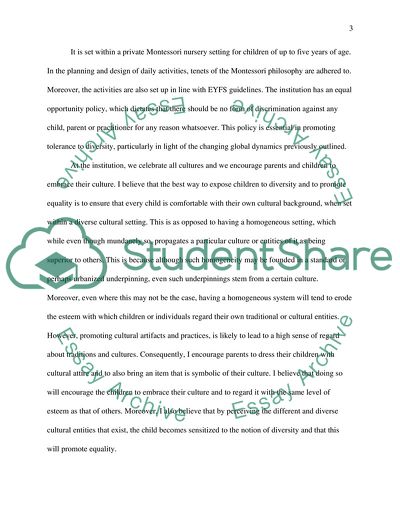Cite this document
(How Settings Can Be Used to Evoke Childrens Opinions Literature review Example | Topics and Well Written Essays - 3000 words, n.d.)
How Settings Can Be Used to Evoke Childrens Opinions Literature review Example | Topics and Well Written Essays - 3000 words. https://studentshare.org/education/1870887-a-report-on-a-small-action-research-evaluating-an-aspect-of-practice-in-relation-to-diversity-and-equalities-which-details-the-ways-in-which-childrens-views-were-elicited-and-the-subsequent-changes-made-to-practice-and-provision
How Settings Can Be Used to Evoke Childrens Opinions Literature review Example | Topics and Well Written Essays - 3000 words. https://studentshare.org/education/1870887-a-report-on-a-small-action-research-evaluating-an-aspect-of-practice-in-relation-to-diversity-and-equalities-which-details-the-ways-in-which-childrens-views-were-elicited-and-the-subsequent-changes-made-to-practice-and-provision
(How Settings Can Be Used to Evoke Childrens Opinions Literature Review Example | Topics and Well Written Essays - 3000 Words)
How Settings Can Be Used to Evoke Childrens Opinions Literature Review Example | Topics and Well Written Essays - 3000 Words. https://studentshare.org/education/1870887-a-report-on-a-small-action-research-evaluating-an-aspect-of-practice-in-relation-to-diversity-and-equalities-which-details-the-ways-in-which-childrens-views-were-elicited-and-the-subsequent-changes-made-to-practice-and-provision.
How Settings Can Be Used to Evoke Childrens Opinions Literature Review Example | Topics and Well Written Essays - 3000 Words. https://studentshare.org/education/1870887-a-report-on-a-small-action-research-evaluating-an-aspect-of-practice-in-relation-to-diversity-and-equalities-which-details-the-ways-in-which-childrens-views-were-elicited-and-the-subsequent-changes-made-to-practice-and-provision.
“How Settings Can Be Used to Evoke Childrens Opinions Literature Review Example | Topics and Well Written Essays - 3000 Words”. https://studentshare.org/education/1870887-a-report-on-a-small-action-research-evaluating-an-aspect-of-practice-in-relation-to-diversity-and-equalities-which-details-the-ways-in-which-childrens-views-were-elicited-and-the-subsequent-changes-made-to-practice-and-provision.


